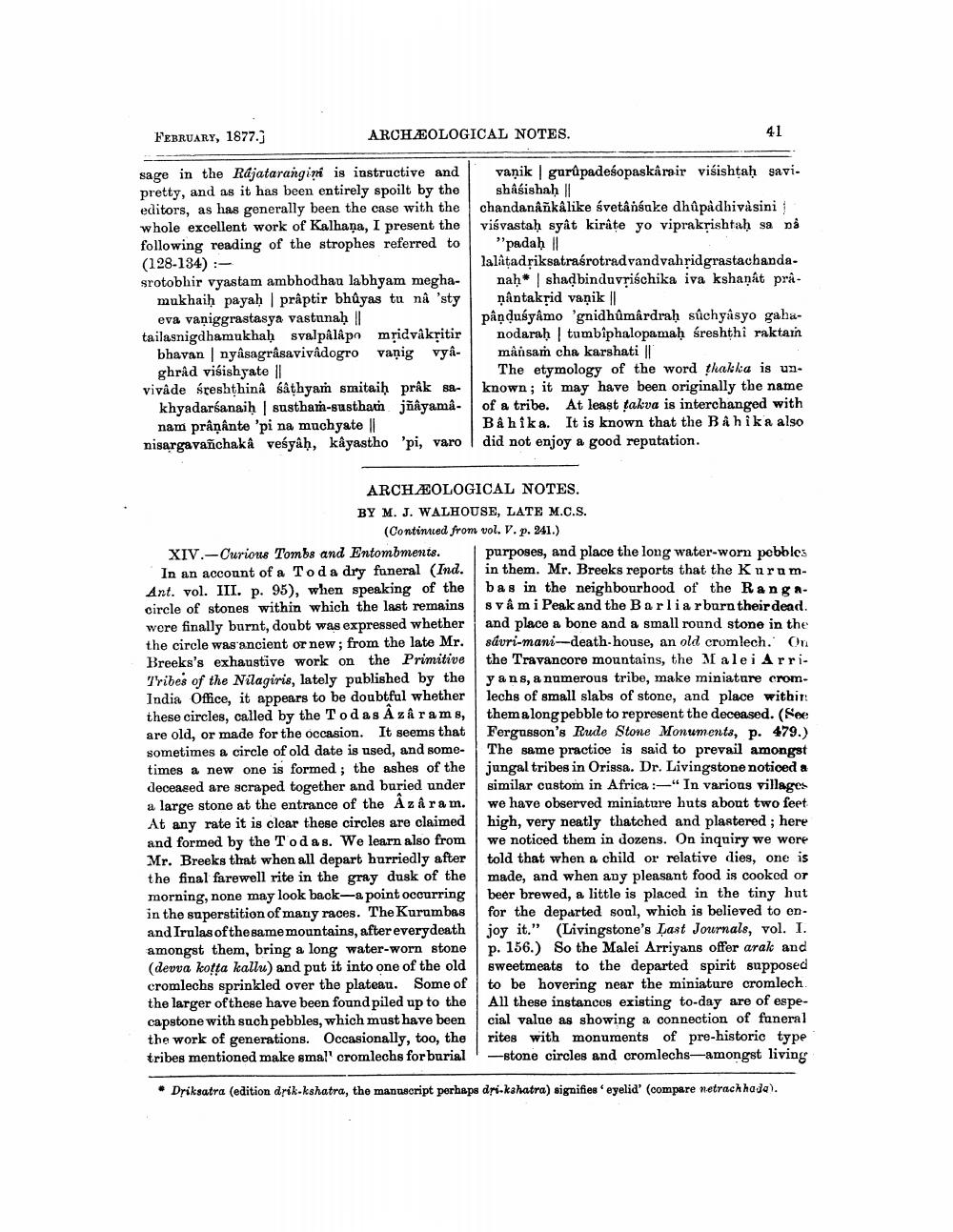________________
FEBRUARY, 1877.]
ARCHÆOLOGICAL NOTES.
41
sage in the Rajatarangini is instructive and vanik gurupadesopaskårair visishtah gavi. pretty, and as it has been entirely spoilt by the shåśishah || editors, as has generally been the case with the chandanañkálike svetánsoke dhûpådhivasini whole excellent work of Kalhaņa, I present the | viśvastah syât kirâte yo viprakrishtah sa på following reading of the strophes referred to "padah Il (128-134) :
lalatadriksatraśrotradvandvahridgrastachandasrotobhir vyastam ambhodhau labhyam megha- nah shadbinduvrischika iva kshaņât pramukhaih payah prâptir bhūyas tu nå 'sty ņântaksid vaņik | eva vaniggrastasya vastunah |
pânduśyamo 'gnidhûmîrdrah súchyasyo gahatailasnigdhamukhaḥ svalpålậpo mridvakritir nodarah tumbîphalopamah Sreshthi raktai
bhavan nyâsagrâsavivadogro vanig vyâ- månsam cha karshati || ghråd viśishyate 11
The etymology of the word thakka is un. vivåde sreshthina sathyam smitaiḥ praksa- known; it may have been originally the name
khyadarśanaih sustham-susthan jñâyamâ- of a tribe. At least takva is interchanged with nam prâņAnte 'pi na muchyate |
Bå hika. It is known that the Bahika also nisargavañchakâ vesyâh, kåyastho 'pi, varo did not enjoy a good reputation.
ARCHÆOLOGICAL NOTES. BY M. J. WALHOUSE, LATE M.C.S.
(Contined from vol. V. p. 241.) XIV.-Curious Tombs and Entombments. purposes, and place the long water-worn pebbles In an account of a Tod a dry funeral (Ind. in them. Mr. Breeks reports that the KurumAnt. vol. III. p. 95), when speaking of the bas in the neighbourhood of the Rangacircle of stones within which the last remains s vámi Peak and the Barlia r burn their dead. were finally burnt, doubt was expressed whether and place a bone and a small round stone in the the circle was ancient or new ; from the late Mr. savri-mani---death-house, an old cromlech. On Breeks's exhaustive work on the Primitive the Travancore mountains, the Malei ArriTribes of the Nilagiris, lately published by the I yans, a numerous tribe, make miniature cromIndia Office, it appears to be doubtful whether lechs of small slabs of stone, and place withir: these circles, called by the Todas A zâ rams, them a long pebble to represent the deceased. (See are old, or made for the occasion. It seems that Fergusson's Rude Stone Monuments, p. 479.) sometimes a circle of old date is used, and some- The same practice is said to prevail amongst times a new one is formed; the ashes of the jungal tribes in Orissa. Dr. Livingstone noticed a deceased are scraped together and buried under similar custom in Africa :-" In various villages a large stone at the entrance of the Azâ ram. we have observed miniature huts about two feet At any rate it is clear these circles are claimed high, very neatly thatched and plastered; here and formed by the Todas. We learn also from we noticed them in dozens. On inquiry we were Mr. Breeks that when all depart hurriedly after | told that when a child or relative dies, one is the final farewell rite in the gray dusk of the made, and when any pleasant food is cooked or morning, none may look back-a point occurring beer brewed, a little is placed in the tiny hut in the superstition of many races. The Kurumbas for the departed soul, which is believed to enand Irulas of the same mountains, after everydeath joy it." (Livingstone's Last Journals, vol. I. amongst them, bring a long water-worn stone p. 156.) So the Malei Arriyans offer arak and (devva kotta kallu) and put it into one of the old sweetmeats to the departed spirit supposed cromlechs sprinkled over the plateau. Some of to be hovering near the miniature cromlech. the larger of these have been found piled up to the All these instancos existing to-day are of especapstone with such pebbles, which must have been cial value as showing a connection of funeral the work of generations. Occasionally, too, the rites with monuments of pre-historic type tribes mentioned make smal' cromlechs for burial - stone circles and cromlechs-amongst living
• Driksatra (edition drik-kshatra, the manuscript perhaps dri-kahatra) signifies eyelid' (compare netrach hada).




